¿Quieres aumentar el tamaño máximo de subida de archivos en WordPress?
A veces, un límite bajo de tamaño de subida de archivos puede impedirle subir archivos con el cargador de medios o instalar plugins y temas de WordPress más grandes.
En este artículo, le mostraremos cómo aumentar fácilmente el tamaño máximo de subida de archivos en WordPress para corregir esos problemas.
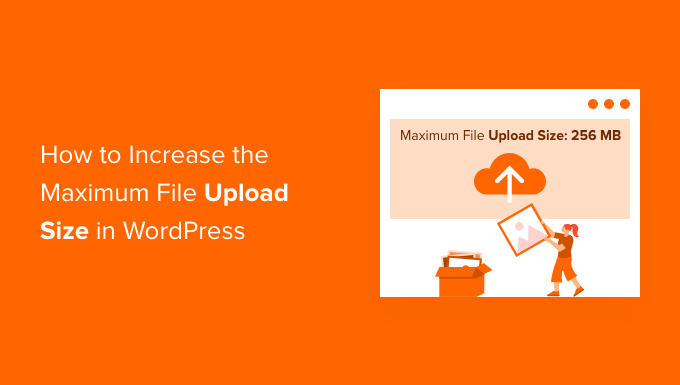
¿Por qué aumentar el tamaño máximo de subida de archivos en WordPress?
Tu proveedor de alojamiento de WordPress establecerá por defecto un tamaño máximo de subida de archivos cuando accedas e instales WordPress. Tu proveedor de alojamiento define este límite, que suele oscilar entre 2 MB y 500 MB.
Para la mayoría de los propietarios de sitios web en WordPress, este límite será más que suficiente.
Sin embargo, hay ocasiones en las que necesitará aumentar este límite para no encontrarse con errores de subida.
Por ejemplo:
- Tienes un sitio web de fotografía y necesitas subir imágenes grandes.
- Su porfolio de diseño o fotografía tiene imágenes grandes.
- Quieres instalar un tema o plugin de WordPress más grande.
- Quieres vender productos digitales como libros electrónicos, fotos, vídeos, etc.
- Actualiza regularmente el contenido y añade audio, fotos y mucho más.
Dicho esto, vamos a mostrarle cómo puede aumentar el tamaño máximo de subida de archivos en su sitio WordPress.
Nota: Ten en cuenta que mostrar muchos archivos grandes en tu sitio web puede ralentizar seriamente su velocidad y rendimiento. Por eso, normalmente recomendamos no subir nunca vídeos a WordPress.
Dado que la mayoría de los usuarios tienen diferentes configuraciones de alojamiento de WordPress, cubriremos lo siguiente:
- How to Check Your Maximum File Upload Size Limit in WordPress
- Method 1: Contact Your WordPress Hosting Provider
- Method 2: Create or Edit an Existing php.ini file
- Method 3: Add Code to Your WordPress Theme functions.php File
- Method 4: Add Code to Your .htaccess File
- Method 5: Use a WordPress Plugin to Increase File Upload Size
Tutorial en vídeo
Si prefiere instrucciones escritas, siga leyendo.
Cómo comprobar el límite de tamaño máximo de subida de archivos en WordPress
WordPress mostrará automáticamente el límite de tamaño máximo de subida de archivos cuando esté subiendo imágenes u otros medios.
Para comprobarlo, simplemente vaya a Medios ” Añadir nuevo en su panel de administrador de WordPress, y verá el límite de tamaño máximo de subida de archivos para su sitio WordPress.
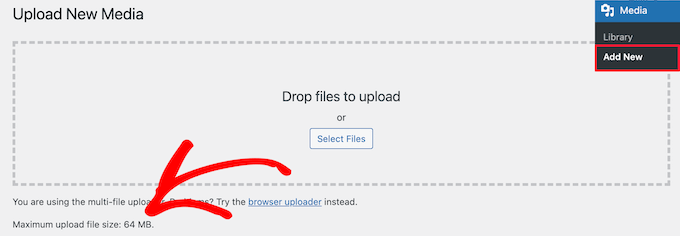
Ahora que ya sabe cómo encontrar el límite de tamaño, vamos a mostrarle cómo aumentar el tamaño máximo de subida en WordPress.
Método 1: Póngase en contacto con su proveedor de alojamiento de WordPress
Una de las formas más sencillas de aumentar el tamaño máximo de subida de archivos en WordPress es ponerse en contacto con su proveedor de alojamiento de WordPress.
Se trata de una tarea relativamente sencilla para su equipo de atención al cliente y puede realizarse en un par de minutos.
Para los principiantes, esto puede ser mucho más fácil que añadir código a WordPress y editar los archivos del servidor.
Sólo tienes que ir al sitio web de tu proveedor de alojamiento, como Bluehost, y acceder.
A continuación, haga clic en el icono “Chat” situado en la parte inferior de la pantalla. A continuación, puede solicitar al personal de soporte que aumente el tamaño de subida de archivos en su sitio de WordPress.
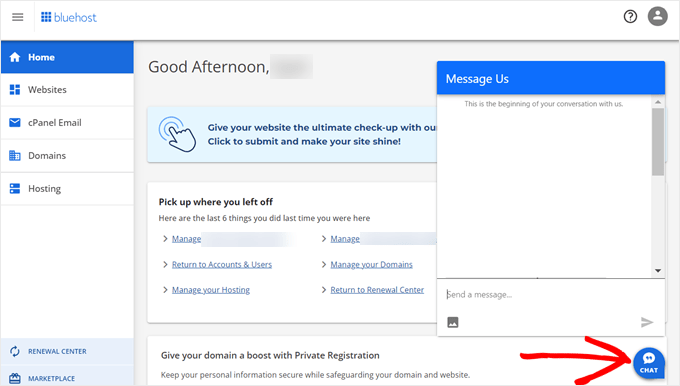
También puede contactar con el soporte desde el Escritorio de su cuenta de alojamiento.
Método 2: Crear o editar un archivo php.ini existente
Otra forma de aumentar el tamaño máximo de subida de archivos es creando o editando un archivo llamado php.ini. Este archivo controla una gran cantidad de ajustes para su entorno de alojamiento de WordPress.
La mayoría de los proveedores de alojamiento de WordPress, como Bluehost, disponen de un cPanel fácil de usar que te ayudará a gestionar tu sitio web.
Si tu alojamiento web tiene un Escritorio cPanel, entonces puedes aumentar el tamaño de subida de archivos a través de las herramientas integradas.
Nota: Lo siguiente es del cPanel de Bluehost. Sin embargo, la mayoría de los proveedores de alojamiento compartido tendrán pasos similares.
Encontrará un botón cPanel en la parte inferior de la pestaña Alojamiento en Bluehost.
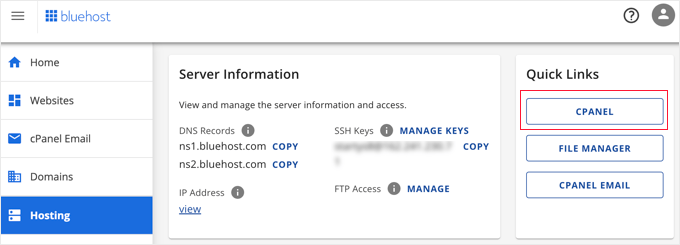
Al hacer clic en este botón se abrirá su Escritorio de cPanel.
Ahora tienes que desplazarte hasta la sección Software y hacer clic en ‘MultiPHP INI Editor’.
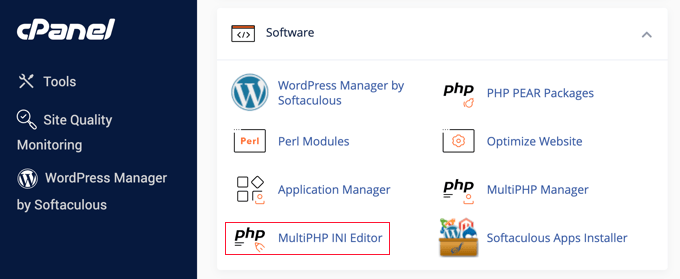
A continuación, desplácese hasta la sección “upload_max_filesize” e introduzca un nuevo tamaño máximo de archivo en la casilla.
A continuación, haga clic en el botón “Aplicar”.
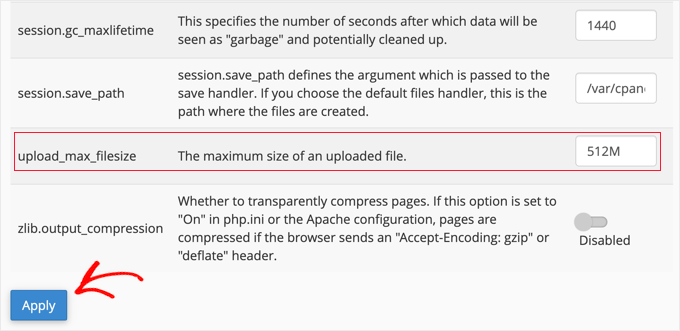
También puede hacer clic en la pestaña del menú “Modo editor” y, a continuación, modificar el tamaño máximo de subida de archivos directamente en el editor.
Tienes que editar la sección ‘upload_max_filesize’ para aumentar el tamaño de subida de tus archivos.
Cuando hayas terminado, sólo tienes que hacer clic en el botón “Guardar”.
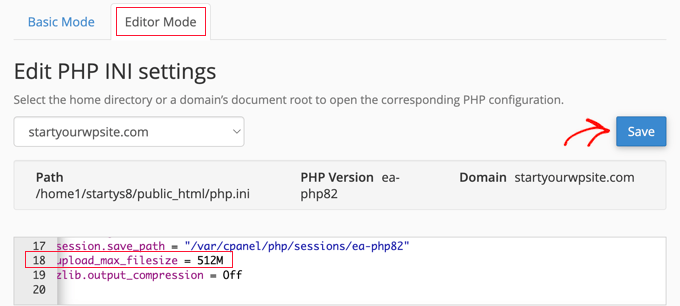
Editar php.ini añadiendo código
Si su proveedor de alojamiento actual no ofrece la opción de cPanel, tendrá que editar este archivo manualmente.
Para ello, puede utilizar un cliente FTP o la opción de gestión de archivos de su panel de control de alojamiento de WordPress.
Si utiliza alojamiento compartido, es posible que no vea el archivo php.ini en el directorio de su alojamiento. Si no lo ves, simplemente crea un archivo llamado php.ini y súbelo a tu carpeta raíz.
A continuación, añada el siguiente fragmento de código al archivo:
upload_max_filesize = 256M
post_max_size = 256M
max_execution_time = 300
Puedes modificar el límite de ‘256M’ al tamaño de archivo que necesites para tu blog de WordPress.
Método 3: Añadir código al archivo functions.php de su tema de WordPress
Este método consiste en añadir código al archivo functions. php de su tema de WordPress.
En lugar de editar el archivo directamente, le recomendamos que utilice WPCode. Es el mejor plugin de fragmentos de código que le permite añadir código a su sitio web sin romper su sitio web.
Si no lo ha hecho antes, consulte nuestra guía para principiantes sobre cómo añadir código personalizado en WordPress.
En primer lugar, debe instalar el plugin gratuito WPCode. Para más detalles, consulta nuestra guía paso a paso sobre cómo instalar un plugin de WordPress.
Una vez activado, deberá ir a Fragmentos de código ” + Añadir fragmento. Deberá pasar el cursor por encima de la opción “Añadir su código personalizado” y, a continuación, hacer clic en el botón “Usar fragmento”.
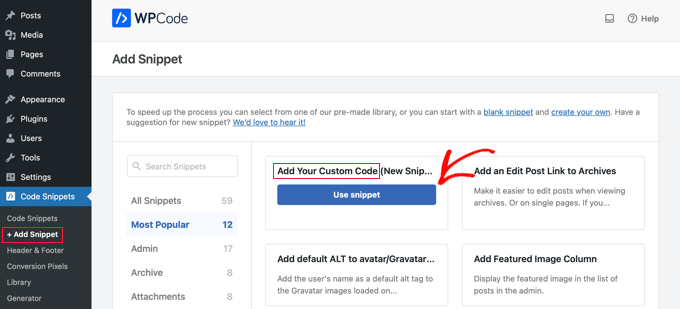
En la siguiente pantalla, debe dar un nombre a su nuevo fragmento de código y cambiar el tipo de código a “Fragmento PHP”.
A continuación, puede copiar y pegar el siguiente fragmento de código en ‘Vista previa del código’. Asegúrate de cambiar ‘256M’ por el tamaño máximo de archivo que necesites:
@ini_set( 'upload_max_size' , '256M' );
@ini_set( 'post_max_size', '256M');
@ini_set( 'max_execution_time', '300' );
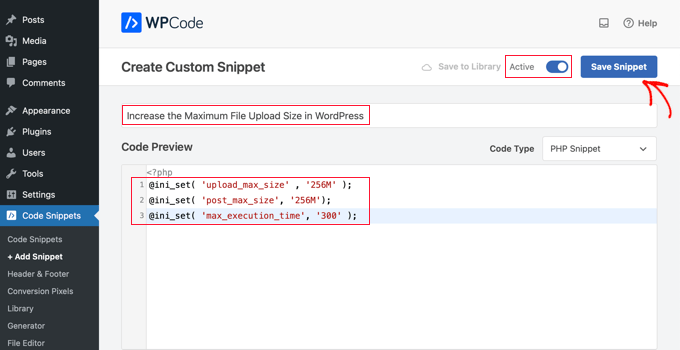
Por último, cambie el conmutador de la parte superior a “Activo” y, a continuación, haga clic en el botón “Guardar fragmento de código”. El código se ejecutará en su sitio web.
Método 4: Añadir código a su archivo .htaccess
Otra forma de aumentar el tamaño máximo de archivo es modificando el archivo .htaccess. Este archivo controla los ajustes de configuración de alto nivel de su sitio web.
Para ello, debe acceder al servidor de su sitio web a través de FTP. Si no ha hecho esto antes, consulte nuestra guía sobre cómo usar FTP para subir archivos a WordPress para principiantes.
A continuación, localice el archivo .htaccess en la carpeta raíz de su sitio web.

Si no puedes encontrar tu archivo .htaccess, entonces podría estar oculto por tu gestor de archivos o cliente FTP. Para obtener más información, consulte nuestra guía sobre por qué no puede encontrar el archivo .htaccess en su sitio de WordPress.
A continuación, debe añadir el siguiente fragmento de código a su archivo .htaccess:
php_value upload_max_filesize 256M
php_value post_max_size 256M
php_value max_execution_time 300
php_value max_input_time 300
Para aumentar aún más el tamaño máximo de subida de archivos, sólo tiene que cambiar ’64M’ por el tamaño que necesite.
Método 5: Utilizar un plugin de WordPress para aumentar el tamaño de la subida de archivos
Otra forma de aumentar el límite máximo de subida de archivos es usando el plugin WP Increase Upload Filesize. Si no te sientes cómodo añadiendo código a WordPress, entonces esta podría ser una buena opción para ti.
Lo primero que tienes que hacer es instalar y activar el plugin. Para más detalles, consulte nuestra guía sobre cómo instalar un plugin de WordPress.
Una vez activado, vaya a Medios ” Aumentar límite de subida en su panel de administrador de WordPress.
Esto le lleva a una pantalla en la que puede seleccionar un nuevo tamaño de archivo subido en el desplegable “Elegir tamaño máximo de archivo subido”.
A continuación, haz clic en el botón “Guardar cambios”.

Nota: El tamaño máximo de subida de archivos lo establece tu proveedor de alojamiento. Si necesita un límite de tamaño de archivo superior al que aparece en el desplegable, deberá ponerse en contacto con su proveedor de alojamiento y solicitar un aumento del límite.
Esperamos que este artículo te haya ayudado a aumentar el tamaño máximo de subida de archivos en WordPress. Puede que también quieras ver nuestra guía práctica sobre cómo elegir el mejor maquetador de sitios web y nuestra selección experta de las mejores aplicaciones de números de teléfono virtuales para empresas con opciones gratuitas.
If you liked this article, then please subscribe to our YouTube Channel for WordPress video tutorials. You can also find us on Twitter and Facebook.





Syed Balkhi says
Hey WPBeginner readers,
Did you know you can win exciting prizes by commenting on WPBeginner?
Every month, our top blog commenters will win HUGE rewards, including premium WordPress plugin licenses and cash prizes.
You can get more details about the contest from here.
Start sharing your thoughts below to stand a chance to win!
Sushil Kumar says
Thank you Yasir Imran it works for me via .htaccess
Pedro Viana says
.htaccess rules! thanks.
Amit Kumar Gupta says
Very useful Article for me . Thanks wpbeginner
Steve S says
I figured out a work-around that does not involve messing with php.ini, .htaccess, functions.php, or any other systtem files. All I did was the following:
* FTP the file up to /wp-content/uploads/year/month/filename.mp4
* New Post –> Add Media –> Insert from URL
* Cut and paste the appropriate URL based on where you uploaded the file.
* Hit Insert Into Post. Done.
kenny says
Perfect! ps if you are inserting an image for a slide background in slider Revolution, use option ‘External URL’
vic says
the .htaccess worked fine for me. thanks alot
Anchal Singh says
my website have got the same issue but thanks to this post its now work perfect
Matt says
Thanks. I want to also know how to make a website portal using wordpress. Any information from you will be highly appreciated.
marta says
Thanks. For me htaccess Method did his job
Rifqi Arief says
Thanks Bro, Its Work On My Free Hosting via .htacess
RT says
Please try below steps as well after creating the php.ini
(1) Go to My Sites -> Network Admin -> Settings from WordPress admin dashboard.
(2) Uncheck the checkbox for “Site upload space: Limit total size of files uploaded to 10 MB” and Save changes.
(3) Done.
Regards,
-RT
Suika says
Thanks, I forgot there was a setting there for that.
Abhishek says
I’m on goddady hosting, none of the 3 solutions worked for me.
But some users reported .user.ini file worked for them in goddady.
can anybody tell me where to put this file?
I have tried root folder and wp-admin folder nothing worked.
Raman Gutyan says
htaccess Method is working great in my localhost.
Thanks for sharing.
DVR says
If you are hitting a wall. Go to your host. Advance setting for PHP. Scan the code looking for max upload & file size. Change it to your required setting.
Done.
See NICOLAS’ reply above.
martin kendall says
Hi DVR I had tried everything and nothing worked, with what had been posted here. I tried multi times in every why to get it to work. Nothing, but your post put me on the correct answer. Thanks very much for that.
Ok this is what i did, Signed into my host server, where my website is. the host server runs on cPanel and the theme is paper_lantern. It should not matter what your sever is or the theme. If you do not have access to this area you will have to get your host to make the changes y cotacting your technical help.
In the panel you will have categories like = files, database, domains, email etc and what you are looking for is software, under software / apps look for multiPHP INI Editor or something like that. Its going to be different on other platforms but should be in that area. What you are looking for is configure PHP INI basic settings or editor mode. I got offered home directory or my domain name. I picked the domain name but maybe need to change both but I did not need to. Scrolled down to upload_max_filesize and changed to 64M but this did not work as you have to also change the momory_limit to 64M also. They have to be the same figure. and then it will work.
Has I understand, when you make the changes in wordpress code. the instruction talk to your data base through the PHP files and instruct the server software to change the database settings. For some reason It would not work for me. So this route, bypass that and making the changes on the server software and not on the wordpress software. In future I will go this way as it was really quick. I hope this helps as a last resort. Martin p.s. this was WordPress 4.8.1 and I found that it did not have, after loading it any PHP.INI or .htaccess files. I did install them but made no difference and or where I put them.
Jeet Patel says
THank you so much it’s working really
Silentnight says
Thank u so much… I increased my uploading size.
Gopi krishnan says
For me, this is not working, but i did this in htaccess file in this way,
php_value post_max_size 10M
php_value upload_max_filesize 40M
php_value memory_limit 500M
This works !
agnieszka00 says
Thank you!!!!!
Michael Serovey says
I have my websites hosted with GoDaddy and so far, NONE of the above suggestions have worked! I have paid for this plugin and now I that I wasted my money!
Paul says
Hi,
To avoid the plugin upload limit you can just upload the plugin with filezilla to your plugin directory. After uploading you can extract the zip file in the file manager and after you have done this the plugin is visible and ready to activate in your admin –> plugin panel
Hope this helped.
Cheers
Pooya says
WOW! THANK YOU PAUL!!
This worked perfectly for me!
and it is MUCH easier and more reliable than any of those methods.
just go to File Directory under the cPanel -> Public-html -> [ you site folder] -> wp-content ->themes or plugins
Then upload the zip file here and extract it.
login to your wp-admin dashboard. and bam, you got yourself the theme or plugin.
Tom says
Thank the Lord (paul) this took way too long.
Nicolas says
Just go to your hosting control pannel -> Advanced -> PHP Settings -> upload_max_filesize ( it usually is on 2M you can change it up to 8M in my case… the point is that it shouldn’t be higher than your post_max_size)
You are welcome!
Jake says
Best answer yet.
Steven Gliebe says
functions.php is not the best place to put the code because raising the PHP max upload size limit is unrelated to a specific theme. Users shouldn’t be changing theme files directly anyway. wp-config.php is probably a better place. The .htaccess or php.ini method is even better (or just ask the host).
Stephanie says
php.ini needs to be in wp-admin folder. This article states it needs to be in the root, which I tried but it made no difference. FYI
Thank you for the information!
Aaron says
Thanks so much for your reply Stephanie. Your information was exactly what I needed.
Mike Serovey says
So far, NONE of the above suggestions have worked. My control panel does NOT allow me to change the PHP Settings, modifying the .htaccess created an internal server error and modifying the theme failed to work as well. Have any other suggestions?
Mike Serovey says
With GoDaddy hosting, I discovered that I needed to use the lines of code that someone posted for the .user.ini file and then refresh my browser and recheck the plugin about three times each before the thing FINALLY worked!
Robert says
Thank you! ini file need to be uploaded in wp-admin folder.
Emmanuel Parbey says
Thank you.
It worked perfectly.
Somnath says
@Stephnie Thanks a Lot .It Workz
Sorin says
In wp-admin put php.ini and work
Angel Rodriguez says
This worked for me as well.
shemmy says
thanks ..this works fine
Prabhat says
yes this is helpfull
Matt says
Worked Immediately! Thanks! By the way if anyone else wants to know, my host is BlueHost and I am using a Genesis Theme.
Panagiotis Sakalakis says
Using the .htaccess I got an Internal Error, and then I just removed the code and it fixed. After that, I created a php.ini file in /public_html/wp-admin, pasted the code and saved it. Everything’s work like a charm now and I can upload my files just fine without any problem.
Umesh Shejole says
Yes, Useful……
Subin Babukuttan says
htaccess worked fine .thanks 4 d post
hol says
Hi
Does anyone know why if the PHP.INI file is changed as mentioned why when the file has completed to 100% nothing happens and it displays http error.
I can upload small files and small videos.
I cant upload anything bigger than say 200mb
I had this working and accepting larger files then I had a restore done on website.
I have changed the PHP.INI…
Is there any reason why just large files don’t work ?
do I need to edit the hta.access file ?
thanks
Ian says
.htaccess method worked for Media Temple grid hosting, others didnt affect it, just in case anyones wondering…
Jay says
IF YOUR STILL FINDING NOTHING IS WORKING..
(In my case the problem was with WP MULTISITES)..,
FIRST CHECK THE FOLLOWING:
1. check your hosting limits (although this was not my problem) make sure your hosting allows the limit you are trying to set ie if on a shared hosting you might find the maximum is 64M.
NOTE: The following solution may also apply If in WordPress, Maximum upload file size will not change even when changed in the php.ini file etc.
The 1M max upload problem lies with WP MULTISITES default settings!!
To change this, do the following to change the Maximum upload file size within WP admin:
LOG INTO YOUR ADMIN DASHBOARD:
1. At the top, hover over My Sites and then click Network Admin.
2. At the left, hover over Settings and then click Network Settings.
3. Scroll to the bottom of the page and change the Max upload file size to whatever you would like in KB.
4. Click Save Changes.
Hope this helps
Gregg says
YESSSS. Thank yo sir.
Milton says
Thanks Jay you were right on point for WP multisites
Denis says
Worked for me. The site used to work and I couldn’t understand why it didn’t anymore. It was my conversion to multisite which caused the ptoblem.
Sam says
Amazing!!! This works!
Adam says
Thanks!!!! Jeez there’s not much help on the changes mutli-site makes!
Bhanu uday says
It worked like a charm. Thank you very much.
AmanDeep Singh says
Working !.I use Create or Edit an existing PHP.INI file method and after applying the settings as mentioned in the article now i am able to upload themes and plugins which are large in size.Thanks for sharing solution.
Judy says
I am new to WordPress, I usually use Joomla but I have a new client that wants a WordPress site. When trying to upload images the WordPress message was that the file limit was 3Mb. I spent hours searching websites for an answer. I am using WAMP and localhost to create the site. Through localhost phpinfo() I could verify which php.ini was active, the one in Apache. I had a file limit of 64Mb but still WordPress had a 3Mb limit. This site gave the instructions under #3 to edit the .htaccess file in the WordPress folder. I copied and pasted the text into this file and IT WORKED! Thank you wpbeginner.
KenSanDiego says
forgot to mention, my WP site is in a subdirectory with a domain pointer. Powweb’s php applies to everything in all subdirectories. So if you have any installations in subdirectories the change applies to all installations.
Ugyen Zangmo says
Create php.ini in wp-admin folder
In the file put the following 3 lines:
upload_max_filesize = 2048M
post_max_size = 2048M
max_execution_time = 3000
Goto to your website as admin and check the upload new media page, it should now display Maximum upload file size: 2 GB.
Thanks to Yasir Imran for sharing your tip!
This worked for me. Thank you James for sharing the Yasir Imran tip. Cheers
sadiq says
it is not working i have done same
in godaddy server
Raton Miah says
working!
Brendan says
That was a great tip… it worked for me.. thanks!
Ben says
Holy crap! Thanks so much man, after the last wordpress update to 4.3.1 my upload size reverted back to the default of 50 MB even though my php.ini, .htaccess, and wp-config.php files hadn’t changed and were still reflecting a max upload size of 512 MB! You’re a hero!
Alain says
Thank you very much!
I tried ALL of the three methods with no results.
I asked the webhost and the raised the limit to 40 MB.
Then, finally, I tried yours and it worked fantastically!
dominio público says
post_max_size should be larger than upload_max_filesize to allow room for other information. The defaults are 2MB max file size and 8MB max post size.
From PHP’s documentation:
post_max_size integer
Sets max size of post data allowed. This setting also affects file upload. To upload large files, this value must be larger than upload_max_filesize.
Nori says
Thanks for this! Tried the php.ini and I am quite surprised it worked and was so easy
Dan says
php.ini file worked perfectly for me. I simply changed the existing values to 100M. All good. Thanks for the advice.
James says
Create php.ini in wp-admin folder
In the file put the following 3 lines:
upload_max_filesize = 2048M
post_max_size = 2048M
max_execution_time = 3000
Goto to your website as admin and check the upload new media page, it should now display Maximum upload file size: 2 GB.
Thanks to Yasir Imran for sharing your tip!
Zain says
Hy,
Please tell me the names of best themes for softwares/download sites?
i am waiting.
Thanks,
Zain.
Markus Aurelius says
Nothing of the above worked for me on GoDaddy so I had to use .user.ini instead of php.ini and that worked fine. Thanks for pointing me in the right direction!
Keith says
Thank you so much. I am on GoDaddy and this worked whereas several other methods did not.
Raj Kothari says
Hi Keith, can you tell me under which folder you have put this file? .user.ini
Need help
Oliver says
Thanks .user.ini worked for me on Godaddy
sam says
1:- open “C:wampbinapacheapache2.4.9bin” folder and find “php” which is a configuration file and open it in ur notepad and again find “upload_max_filesize” and “post_max_size” and change both and save.
2:- open “C:wampbinphpphp5.5.12” folder and find “php” and “phpforapache” which are configuration file and open both in ur notepad and again find “upload_max_filesize” and “post_max_size” and change both and save.
3:- finally restart all services of wamp and enjoy…lov u all
Decb says
Hi Guys, I’m REALLY new to this but can you look at what I see when I click to edit the .htaccess file – where do i add the code? at the start? at the end? Do I put my cursor at the begining and click return (then put it in) ??? Please help
Gerard ONeill says
Deb, it wouldn’t matter where you added it; but make sure its outside of a block. To be safe, just add it at the end.
However, the better way (as of php5.5) is to modify the .user.ini file in a per directory basis. If you did the top level directory, it would apply to all sub directories (unless overridden).
http://php.net/manual/en/configuration.file.per-user.php
And obviously the system wide php.ini works too.
BenPDX says
+1 for Alex’s solution. Upload php.ini folder to wp-admin folder worked for me on Lithium Hosting. 30 second Google search and 1 min to create text file and upload to server!
Dede Erik says
I choice the third method and this is worked to me, thanks so much
Hasan Tareq says
.htaccess works for my wpenigne site
Vineesh says
Hi alex, you are right. php.ini file should be added to wp-admin folder. It will work perfectly…. thanks alex
Rafael says
Just adding the php.ini file into wp admin folder worked perfectly!!! thanks!
chandan says
thnx alot Alex this worked for me to..
Tony_atf says
I keep getting http error even with your suggestion. im on godaddy I have filesize 300m but anything over 150Mb chokes. it uploads, sits for a few seconds and then the http error displays. wordpress never shows the error.
SunnyK says
same with me. did you found any solution yet?
WPBeginner Staff says
You can connect to your website using an FTP client and undo the changes you made.
Nitesh Magan says
Hey I added the 1st code to my theme function file, but now everything on my site went blank. I cant even access my wp-admin of my site !!
Please Help …
Chris says
If you’re just trying to upload files yourself in the admin panel (media), make a new plain text document, save it as whatever name (including extension) of the large file you’re trying to upload. So if you’re trying to upload “files.zip,” save a blank text document as files.zip. Upload this blank text file you just created in WordPress. Then, go to FTP or file manager, go to wp-content/uploads/(whatever year it is)/(whatever month it is). You should fine files.zip there. Delete that file (which is just a plain text file) then upload the real files.zip, making sure the names match up. Then when you go back to media it will be the right file.
Yasir Imran says
I tried htaccess method and found 500 internal server error, then placed php.ini with 3 given lines in root directory, again didn’t work. Then I placed it in wp-admin folder and it worked. I think the author should mention it.
Alexandre says
This worked for me while everything else had failed. Thanks for sharing.
Mel says
I had the exact same experience and this worked for me. Thanks Yasir!
Les B says
Thank you Yasir Imran…your method works where all others, including .htaccess fails!
(The php.ini must be in the wp-admin folder.)
Les